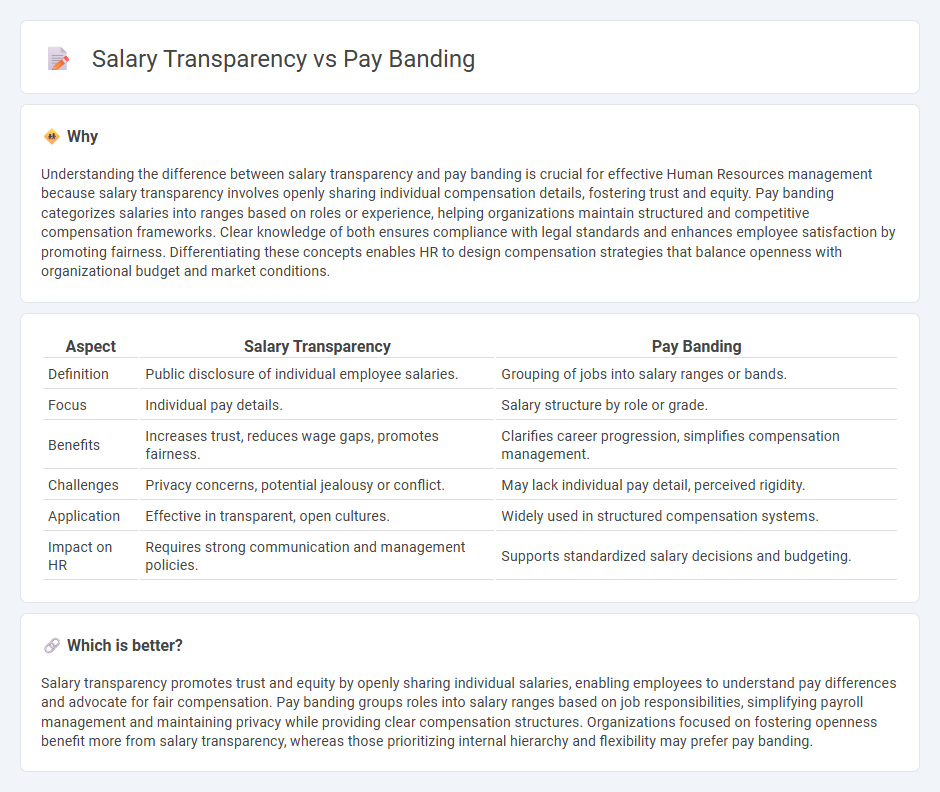
Salary transparency promotes openness by disclosing individual compensation details, fostering trust and reducing pay disparities, while pay banding standardizes salary ranges for specific roles to maintain internal equity and budget control. Both approaches address compensation fairness but vary in implementation and impact on employee motivation and organizational culture. Explore deeper insights to determine the best strategy for your human resources management.
Why it is important
Understanding the difference between salary transparency and pay banding is crucial for effective Human Resources management because salary transparency involves openly sharing individual compensation details, fostering trust and equity. Pay banding categorizes salaries into ranges based on roles or experience, helping organizations maintain structured and competitive compensation frameworks. Clear knowledge of both ensures compliance with legal standards and enhances employee satisfaction by promoting fairness. Differentiating these concepts enables HR to design compensation strategies that balance openness with organizational budget and market conditions.
Comparison Table
| Aspect | Salary Transparency | Pay Banding |
|---|---|---|
| Definition | Public disclosure of individual employee salaries. | Grouping of jobs into salary ranges or bands. |
| Focus | Individual pay details. | Salary structure by role or grade. |
| Benefits | Increases trust, reduces wage gaps, promotes fairness. | Clarifies career progression, simplifies compensation management. |
| Challenges | Privacy concerns, potential jealousy or conflict. | May lack individual pay detail, perceived rigidity. |
| Application | Effective in transparent, open cultures. | Widely used in structured compensation systems. |
| Impact on HR | Requires strong communication and management policies. | Supports standardized salary decisions and budgeting. |
Which is better?
Salary transparency promotes trust and equity by openly sharing individual salaries, enabling employees to understand pay differences and advocate for fair compensation. Pay banding groups roles into salary ranges based on job responsibilities, simplifying payroll management and maintaining privacy while providing clear compensation structures. Organizations focused on fostering openness benefit more from salary transparency, whereas those prioritizing internal hierarchy and flexibility may prefer pay banding.
Connection
Salary transparency fosters trust by openly sharing compensation ranges and criteria, which directly supports the implementation of pay banding by clearly defining salary tiers within an organization. Pay banding organizes jobs with similar responsibilities into structured pay ranges, enabling consistent and equitable salary decisions that align with transparent communication. Together, these practices promote fairness, reduce wage gaps, and enhance employee satisfaction through clear, accessible compensation information.
Key Terms
Compensation Structure
Pay banding organizes compensation into predefined salary ranges based on job roles and experience levels, promoting internal equity and predictable pay progression. Salary transparency involves openly sharing pay information within the organization to foster trust and reduce wage gaps. Explore how integrating pay banding and salary transparency can optimize your compensation structure.
Pay Equity
Pay banding establishes structured salary ranges that promote internal equity by preventing wage disparities across similar roles, while salary transparency openly shares compensation details to foster trust and highlight pay equity concerns. Implementing pay banding reduces subjectivity in salary decisions, contributing to consistent pay practices and supporting compliance with equal pay regulations. Explore how combining pay banding with salary transparency strategies enhances pay equity in your organization.
Internal Communication
Pay banding structures categorize employees into defined salary ranges to enhance internal clarity and promote equitable compensation. Salary transparency involves openly sharing salary information to foster trust, reduce pay disparities, and improve employee engagement. Explore effective internal communication strategies to implement pay banding and salary transparency successfully within your organization.
Source and External Links
What is a Salary Band? | HR & Payroll Glossary - Paylocity - A salary band is a compensation framework that sets the minimum and maximum base pay for specific job categories, helping organizations promote pay equity and streamline compensation decisions.
What is a Salary Band? A Guide for HR Professionals - Indeed - Salary bands group jobs with similar requirements into defined pay ranges, allowing for more effective pay management based on role value, experience, and responsibility.
What Are Salary Bands? | Article - Lattice - Salary bands specify the minimum and maximum pay for a job level, often adjusted by geographic location to reflect local market conditions.
 dowidth.com
dowidth.com